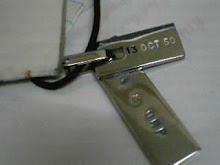
Image : http://www.flickr.com
If you're concerned about stains on your teeth there are four main methods available today for whitening the teeth. I'm going to explain the various methods and how well they work. These teeth whitening and bleaching methods include chairside bleaching or 'power bleaching', professional dispensed bleaching solutions, over-the-counter, TV, and Internet products and whitening toothpastes.
1. Power bleaching or also called chair-side bleaching. A dentist applies a gel or rubber shield to protect the gums and oral tissues and then puts bleach on the teeth. Make sure to ask if the dental bleaching agents the dentist uses has the American Dental Association (ADA) Seal. Sometimes a light or a laser may be used to help the bleach work better. However there aren't any products that use lasers that are accepted by the ADA at this writing. It may take more than one visit for this bleaching treatment. You'll be able to see the results right away, usually about five shades or so brighter. This treatment is supposed to work very well on a wide range of stains. However if your teeth are sensitive or even if they are not, there can be a range of pain experienced during and/or after the procedure. Make sure to do some research before you proceed. This type of dental whitening can be expensive, so make sure to have your dentist fully explain how much it will cost and what results you can expect.
2. Professionally dispensed bleaching solutions. Your dentist can sell you some teeth of these bleaching products for use at home. They usually contain peroxides that bleach the tooth enamel. Most of these products come in a gel form. The gel is placed in a mouth guard or tray that fits snugly inside the mouth around your teeth. How long you allow the gel to work depends on what results you want and your sensitivity to the bleaching gel. Some of these gel products are used for two times a day for about two weeks, and some of the other products are used overnight for one or two weeks. They may or may not help the many different types of staining. It's possible your teeth may turn about five to six shades whiter/brighter with long-lasting results. However the long term effects of the bleach on your sensitive gum tissue and from the possible absorbency into the oral and other bodily tissues is not known.
3. The over-the-counter, TV, and Internet products. These tooth whitening products are for use in your home and include teeth whitening strips, paint-on tooth products, and bleaching gels and trays. They use a lower volume of peroxide. You wear it throughout the day and apply some of it at night just before bedtime. They will have very limited results if you haven't had the stains removed by a dentist first. But they're supposed to help prolong the results you receive from stain removal by a dental professional. They are also supposed to help if the staining is due to age and/or certain foods. Your teeth may turn about two or more shades brighter for up to five months or so.
4. Tooth whitening toothpastes. All toothpastes on the market will help remove surface stain by the action of mild abrasives. Some whitening toothpastes have special polishing agents that remove even more of the stains. These products do not bleach or change the color of teeth; they help some surface stains only. You may see temporary results with some claims your teeth will be one to two shades brighter.
These are the four main methods for whitening the teeth. So before you use any tooth whitening products, have a talk with your dentist first. Your dentist may help you decide which method is the best one for you based on the type of stains that are on your teeth. Remember that not all products will work the same way on each. And it is important to bear in mind that teeth whitening is not in itself make your mouth healthier and can actually create an oral or dental problems for you.


0 Responses to "Teeth whitening - Babysitting Four ways to whiten your teeth or bleach, and what to look out for!"
Post a Comment